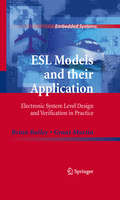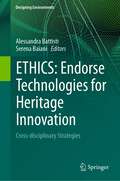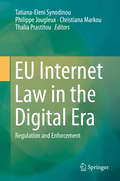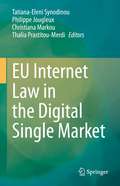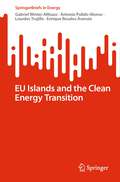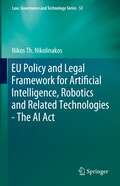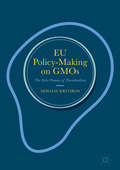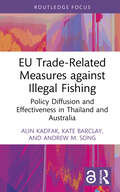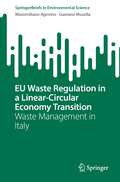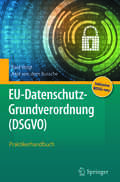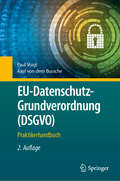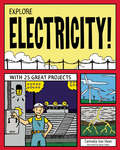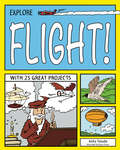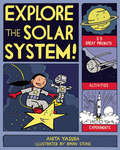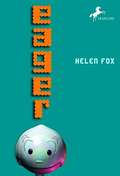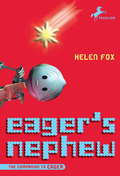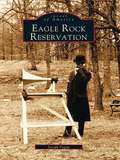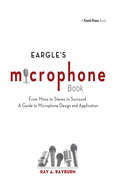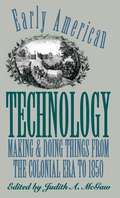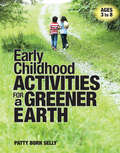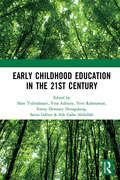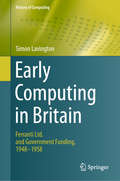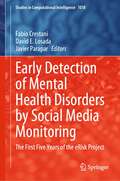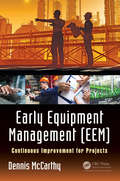- Table View
- List View
ESL Models and their Application
by Brian Bailey Grant MartinThis book arises from experience the authors have gained from years of work as industry practitioners in the field of Electronic System Level design (ESL). At the heart of all things related to Electronic Design Automation (EDA), the core issue is one of models: what are the models used for, what should the models contain, and how should they be written and distributed. Issues such as interoperability and tool transportability become central factors that may decide which ones are successful and those that cannot get sufficient traction in the industry to survive. Through a set of real examples taken from recent industry experience, this book will distill the state of the art in terms of System-Level Design models and provide practical guidance to readers that can be put into use. This book is an invaluable tool that will aid readers in their own designs, reduce risk in development projects, expand the scope of design projects, and improve developmental processes and project planning.
ETHICS: Cross-disciplinary Strategies (Designing Environments)
by Alessandra Battisti Serena BaianiThis book outlines, within the Italian national framework, the current and potential paths oriented towards a new concept of Architectural Heritage, through actions referring to Innovation and Experimentation and Protection and Transformation of the Architectural Heritage. The development of the themes is articulated in two sessions dealing with the aspects related to the analysis and mapping of Architectural Heritage to face the context of the current Climate Crisis and the development of projects and experimentations oriented to the Green and Digital Transition. The evolution of the concept of Heritage, as conceived by the United Nations 2030 Agenda and in the Green Deal and New European Bauhaus, aimed at constructing an inclusive and universally recognised definition to support supranational objectives of sustainable human development, gives rise to innovative strategies, methodologies and technologies that—in a direction of mitigation, contrast and adaptation to climate change—allow for the safeguard, renewed management and a hope for valorisation of Heritage on a national scale. In this direction, the understanding of Architectural Heritage as a 'non-renewable resource' determines the need to activate design experimentation laboratories oriented towards regeneration, articulated and complex, which require, in order to respond to the challenges posed by our era, a sensitive and dialogic multidisciplinary vision of a holistic type. In fact, on the one hand, it is necessary to redefine the usability and management methods of built heritage through the adoption of digital, mobility, energy, ecological, social, green and blue infrastructures; on the other hand, it is necessary to introduce new qualitative and quantitative parameters and performance indicators, adequate to verify the validity of the implemented strategies in a perspective of adaptation to climate change, able to clarify contents, processes and tools to contrast future risks. The pursuit of these objectives refers to the innovation of training paths, professionalising procedures, administrative regulations, and public policies that involve citizens and the private partnership towards a different project qualification and empowerment of stakeholders, inhabitants, professionals, and clients. The Technological Project makes it possible to activate different interventions aimed at acting, in an integrated manner, on assets, context and communities, according to an approach that reinterprets them on a common score, as proposed by the European Next Generation programme in three priority aspects: digitalisation and innovation, environmental transition, increased resilience and social sustainability of national economies. In this scenario, the interventions aimed at outlining sustainable development actions will have to place these concepts at the centre in a harmonious vision that starts from the recognition and enhancement of the Architectural Heritage, recognising it as a fundamental asset of the territories.
EU Internet Law in the Digital Era: Regulation and Enforcement
by Tatiana-Eleni Synodinou Philippe Jougleux Christiana Markou Thalia PrastitouThe book provides a detailed overview and analysis of important EU Internet regulatory challenges currently found in various key fields of law directly linked to the Internet such as information technology, consumer protection, personal data, e-commerce and copyright law. In addition, it aims to shed light on the content and importance of various pending legislative proposals in these fields, and of the Court of Justice of the European Union’s recent case law in connection with solving the different problems encountered. The book focuses on challenging legal questions that have not been sufficiently analyzed, while also presenting original thinking in connection with the regulation of emerging legal questions. As such, it offers an excellent reference tool for researchers, policymakers, judges, practitioners and law students with a special interest in EU Internet law and regulation.
EU Internet Law in the Digital Single Market
by Tatiana-Eleni Synodinou Philippe Jougleux Christiana Markou Thalia Prastitou-MerdiWith the ongoing evolution of the digital society challenging the boundaries of the law, new questions are arising – and new answers being given – even now, almost three decades on from the digital revolution. Written by a panel of legal specialists and edited by experts on EU Internet law, this book provides an overview of the most recent developments affecting the European Internet legal framework, specifically focusing on four current debates. Firstly, it discusses the changes in online copyright law, especially after the enactment of the new directive on the single digital market. Secondly, it analyzes the increasing significance of artificial intelligence in our daily life. The book then addresses emerging issues in EU digital law, exploring out of the box approaches in Internet law. It also presents the last cyber-criminality law trends (offenses, international instrument, behaviors), and discusses the evolution of personal data protection. Lastly, it evaluates the degree of consumer and corporate protection in the digital environment, demonstrating that now, more than ever, EU Internet law is based on a combination of copyright, civil, administrative, criminal, commercial and banking laws.
EU Islands and the Clean Energy Transition (SpringerBriefs in Energy)
by Enrique Rosales-Asensio Gabriel Winter-Althaus Antonio Pulido-Alonso Lourdes TrujilloThis book explains the challenges and barriers of island energy systems in the European Union. It reviews the research projects carried out to date, and proposes a new feasible scheme that could be advantageous to many isolated energy systems. The book contains a thorough literature review, to ensure the originality of its ideas. It provides a clear insight of the opportunities and difficulties facing EU island energy systems.
EU Policy and Legal Framework for Artificial Intelligence, Robotics and Related Technologies - The AI Act (Law, Governance and Technology Series #53)
by Nikos Th. NikolinakosArtificial Intelligence (AI) can benefit our society and economy, but also brings with it new challenges and raises legal and ethical questions. According to the author of this comprehensive analysis, it is imperative to ensure that AI is developed and applied in an appropriate legal and regulatory framework that promotes innovation and investment and, at the same time, addresses the risks associated with certain uses of AI-related technologies.Essential to understanding the relationship between policy and law, this book traces the evolution of EU policy on artificial intelligence and robotics, focusing in particular on the EU’s ethical framework for AI, which defines trust as a prerequisite for ensuring a human-centric approach.The main part of the book provides a thorough and systematic analysis of the Commission’s 2021 proposed AI Act, which establishes harmonised rules for the development, placement on the market and use of AI systems in the EU. The author painstakingly compares the Commission’s proposed AI Act with the numerous “compromise” proposals of the Council of the European Union, leading to the final version of the Council’s AI Act (general approach) and its formal adoption on 6 December 2022. The author also examines with extraordinary detail the amendments proposed by the relevant committees and political groups of the European Parliament, revealing the position the Parliament is likely to adopt in the forthcoming negotiations with the Commission and the Council on the text of the AI Act.Numerous legislative and policy documents are presented in detail, while the analysis also considers the comments made by all interested parties (e.g. the European Commission, Council of the European Union, European Parliament, governmental organisations, national competent authorities, and stakeholders/actors with different/conflicting interests, such as corporations, business and consumer associations, civil society and other non-profit organisations). In the course of its in-depth analysis, this book will provide readers with crucial insight into the reasons behind the European Institutions’ different approaches and the often contradictory interests of stakeholders. Because the policy arguments are carefully balanced and drafted with scrupulous care, this volume will establish itself as a reference resource to be consulted for years to come.
EU Policy-Making on GMOs
by Mihalis KritikosThis book examines the development and implementation of the EU's legislative framework on the commercial release of GMO products as a case study of social regulation operating within a predominantly technical framework. The analysis and findings are based on an extensive documentary analysis and interviews with regulators, risk assessors, public interest groups and biotechnology experts at the national and European levels. It argues that in the case of the EU biotechnology framework, the particular institutional settings created for the formulation and interpretation of its provisions have been of decisive importance in elaborating a proceduralised 'science-based' prior authorization scheme as the preferred framework for granting commercial permits. This interdisciplinary work will appeal to EU lawyers, decision-makers and risk managers as well as academics working in the fields of EU studies, politics, law, risk governance sociology of science/risk and technology assessment. The book is based on a PhD thesis that was awarded with the 2008 UACES Prize for the Best Thesis in European Studies in Europe and with the EPEES 1st Prize for the Best Thesis written by a Greek Researcher between 2004 and 2008.
EU Trade-Related Measures against Illegal Fishing: Policy Diffusion and Effectiveness in Thailand and Australia (Routledge Focus on Environment and Sustainability)
by Kate Barclay Andrew M. Song Alin KadfakFocusing on the experiences of Thailand and Australia, this book examines the impact of trade-restrictive measures as related to the EU’s regulations to prevent Illegal, Unreported and Unregulated (IUU) fishing. It is widely accepted that IUU fishing is harmful, and should be stopped, but there are different approaches to tackling it. Acknowledging this, this book argues that major efforts to fight IUU fishing require careful analyses if the goal is to achieve optimal results and avoid unintended consequences. The book draws on the recent experiences of Thailand and Australia to offer an empirical examination of one increasingly prominent solution, trade-restrictive measures. With Thailand representing direct, active intervention by the EU and Australia a more indirect dispersion of policy narratives and discourses, the book provides a rounded view on how likely it is that different countries in different situations will adapt to the changing policy norms regarding IUU fishing. Understanding the reactions of countries who might be targeted, or otherwise be influenced by the policy, generates new knowledge that helps inform a more effective and scalable implementation of the policy on the part of the EU and a better governance preparedness on the part of non-EU fishing nations. In broader terms, this book exposes a key moment of change in the compatibility between environmental regulations and international trade. The EU IUU policy is a prime example of a policy that uses the mechanisms of international trade to account for environmental and conservation objectives. By way of the unilateral and trade-restrictive stance against IUU fishing, the EU has positioned itself as a major market and normative power, driving its sustainability norms outwards. This book sheds light on the efficacy of this policy setup based on the analysis of country perspectives, which is a key factor influencing its potential spread. This book will be of interest to students and scholars of international fisheries politics, marine conservation, environmental policy and international trade, and will also be of interest to policymakers working in these areas.
EU Waste Regulation in a Linear-Circular Economy Transition: Waste Management in Italy (SpringerBriefs in Environmental Science)
by Massimiliano Agovino Gaetano MusellaWaste management is a topical issue worldwide. In recent years, several requests have been made by citizens and associations to political decision-makers regarding the need for a significant improvement in waste management methods. Particularly considering the significant increase in awareness of social and environmental impacts and the economic consequences of non-virtuous waste management. There is growing attention on legislation and regulation's role in the waste sector. Regulation can help companies and citizens achieve a faster, more effective, and more efficient transition from a linear economy, based on the take-make-dispose paradigm, to a circular economy, in which the potential of waste as resources and secondary raw materials is exploited. This book is set in the wake of economic literature that tackles the transition from the linear to the circular economy. It focuses on the downstream stages of the waste management process (i.e. the waste treatment phase). In this regard, it is proposed a journey through the history of European waste legislation to study the waste sector's transition dynamics from a selfish and no longer sustainable economic model based on rampant consumerism to a far-sighted sustainable model addressing the well-being of future generations. Studying the changes in European waste regulations leads us to ask ourselves the following questions: how has waste collection changed in recent years? What are the new regulatory challenges that must be addressed to achieve the objectives of a circular economy? How successful has the EU legislation been in fostering the transition from a linear to a circular economy? Finally, has the European environmental legislation sprung a convergence process among European countries towards the circular economy, or has the definition of targets fuelled the already marked differences between EU countries?
EU-Datenschutz-Grundverordnung (DSGVO)
by Paul Voigt Axel von dem BusscheDieses Praktikerhandbuch enthält Hinweise zur praktischen Umsetzung der EU-Datenschutz-Grundverordnung (DSGVO) sowie eine systematische Analyse der neuen Vorschriften. Das Handbuch widmet sich unter anderem den organisatorischen und materiellen Datenschutzanforderungen, den Rechten der betroffenen Personen, der Rolle der Aufsichtsbehörden, der Rechtsdurchsetzung und den Bußgeldern nach der Verordnung, sowie nationalen Besonderheiten. Das deutsche Datenschutz-Anpassungs- und Umsetzungsgesetz EU (DSAnpUG-EU) wurde bereits umfassend berücksichtigt. Zusätzlich gewährt das Handbuch einen kompakten Überblick zu den Konsequenzen der Neuregelung für ausgewählte Verarbeitungssituationen mit hoher Praxisrelevanz, wie Cloud Computing, Big Data und Internet of Things. Die im Jahr 2016 verabschiedete DSGVO tritt im Mai 2018 in Kraft. Sie sieht zahlreiche neue bzw. verstärkte Datenschutzpflichten sowie eine deutliche Erhöhung der Bußgelder (auf bis zu 20 Mio. Euro) vor. Nicht nur in der Europäischen Union ansässige Unternehmen werden daher ihre Datenschutz-Compliance auf den Prüfstand stellen müssen; aufgrund des weiten, grenzüberschreitenden Anwendungsbereichs der Verordnung wird ihr Inkrafttreten Auswirkungen auf zahlreiche Unternehmen weltweit haben.
EU-Datenschutz-Grundverordnung (DSGVO): Praktikerhandbuch
by Paul Voigt Axel von dem BusscheDieses Praktikerhandbuch gibt einen praxisnahen Überblick über die Vorgaben der DSGVO und das deutsche Datenschutzrecht. Das Handbuch widmet sich unter anderem den organisatorischen und materiellen Datenschutzanforderungen, den Rechten der betroffenen Personen, der Rolle der Aufsichtsbehörden, den Schadensersatzanspüchen und den Bußgeldern nach der Verordnung, sowie deutschen nationalen Besonderheiten. Es enthält zahlreiche Praxishinweise und Anwendungsbeispiele sowie eine kompakte Übersicht zu den datenschutzrechtlichen Vorgaben für ausgewählte Verarbeitungssituationen mit hoher Praxisrelevanz, wie Cloud Computing, Big Data und Künstliche Intelligenz. Das Handbuch wurde für die zweite Auflage vollständig überarbeitet und berücksichtigt umfangreich neue datenschutzrechtliche Rechtsprechung und Behördenstellungnahmen.
EU-Taxonomie-Konformität im Wohnungsbau: Rückbaubarkeit einzelner Bauteile in der Kreislaufwirtschaft und Lebenszyklusbetrachtung (Entwicklung neuer Ansätze zum nachhaltigen Planen und Bauen)
by Hannah VongerichtenDieses Buch bietet eine umfassende Analyse der EU-Taxonomie-Kriterien für eine Kreislaufwirtschaft und die Taxonomiekonformität im Wohnungsbau. Es wird die Notwendigkeit eines nachhaltigen Wandels im Bausektor angesichts der globalen Herausforderungen des Klimawandels und der Ressourcenknappheit hervorgehoben. Die EU-Taxonomie-Verordnung dient als rechtliche Grundlage für diesen Wandel. Der Fokus liegt auf dem Übergang zu einer Kreislaufwirtschaft im Wohnungsbau und die Rückbaubarkeit einzelner Bauteile, um die Umweltauswirkungen des Bausektors zu minimieren. Dieses Buch präsentiert Lösungsansätze, wie der Bausektor zu einer Kreislaufwirtschaft übergehen kann, um die Umweltauswirkungen zu reduzieren und die Anforderungen der EU-Taxonomie zu erfüllen. Das Buch richtet sich an Studierende, Forschende und Fachleute, die Lösungen für die Herausforderungen der Umsetzung rückbaufreundlicher Gebäudedesigns und der EU-Taxonomie-Kriterien suchen.
EXPLORE ELECTRICITY!
by Carmella Van Vleet Bryan StoneGiven the pace of how we harness and utilize electricity, as well as the importance of developing new sources of energy, electricity is a timely subject for kids to explore. In Explore Electricity! With 25 Great Projects, kids ages 6-9 will learn the basics of electricity: currents, circuits, power, magnetism and electromagnetism, motors and generators. They'll become more attuned to how much they rely on electricity in their daily lives. They'll also understand that while electricity is a wonderful resource, and one we've used to our advantage ever since it was discovered, the future of how we make and use electricity is still changing and there are things they can do today to impact these changes.This title invites kids to experiment on their own with 25 simple projects that will "spark" their learning and enthusiasm, including making their own clothespin switch, lemon battery, compass, electromagnet, and flashlight, as well as generating their own "lightning." These hands-on activities combined with informational text will excite kids about STEM? the interrelated fields of science, technology, engineering, and mathematics.
EXPLORE FLIGHT!
by Bryan Stone Anita YasudaWho invented the airplane? When were airplanes invented? And why do planes have wings if the wings don't flap? Kids can answer these questions and more by jumping into the cockpit and soaring into Explore Flight! With 25 Great Projects, where they'll learn about the history of our human obsession to conquer the feat of flying.For kids ages 6-9, Explore Flight! With 25 Great Projects introduces them to the dreamers, inventors, aviation pioneers, and record breakers. They will read about the myths and legends of flying and about the wondrous flying machines of the past, present and future. They will learn that in the 15th century Leonardo da Vinci drew sketches of airplanes, helicopters and other flying machines, and that the first passengers in a hot air balloon were a sheep, a rooster, and a duck. Along the way, they will develop a better understanding of the rich history of aviation, investigate what causes flight, and learn about the science of aerodynamics. Projects and experiments range from making a paper airplane to building an airfoil. All the projects in this book are easy to follow, require little adult supervision, and use commonly found household products, many from the recycling.
EXPLORE THE SOLAR SYSTEM!
by Bryan Stone Anita YasudaExplore the Solar System! 25 Great Projects, Activities, Experiments introduces kids ages 6-9 to the planets, moons, and other celestial bodies that surround our star, the sun, as well as the universe beyond. Combining a hands-on element with history and science, kids investigate solar eclipses, phases of the moon, Jupiter's rings, and what astronauts wear. Who named the stars? What is the Milky Way? Why is there night? By combining a hands-on element with riddles, jokes, fun facts, and comic cartoons, kids Explore the Solar System!, and have a blast along the way.
Eager (Eager series)
by Helen FoxIt is later this century, and the earth's natural resources have been rationed for use by technocrats. Now LifeCorp, a global company, makes all major decisions and robots do most of the work. Life otherwise is much as we know it (except that your house talks to you and the kettle asks you how many cups of tea you want). <p><p>When the Bell family's much-loved old-fashioned robot butler Grumps starts to go wrong, Mr Bell finds EGR3 through a colleague. But EGR3, known as Eager, is something different - programmed to learn through his experiences, like a human child. <p><p>He also feels wonder, excitement - and confusion; not least a sense of awe at the latest, glamorous BDC4 robots, flaunted by the families of the powerful and wealthy technocrats. And he feels sorrow at the loss of Grumps, destroyed under strange circumstances. <p><p>Then Gavin begins to think there is something odd about the BDC4s behaviour. With his sister Fleur, he investigates, enlisting Eager's help - with hilarious consequences. Questions are asked of LifeCorp and of Eager's creator and the answer to all the puzzles is finally solved. It leaves only the final question to be answered - the one closest to Eager's heart: am I alive?
Eager's Nephew
by Helen FoxIt is the future. Twenty years have passed since Eager' s first adventures with the Bell family. Scientists are now banned from building robots that can think for themselves and feel emotion, like Eager. He and other robots have spent years in hiding. But Eager secretly visits the Bell family, and his headstrong nephew, a most unusual new robot named Jonquil, stows away on the visit. They arrive at the Bells just in time— for mysterious and dangerous things are happening to the family and their friends. Eager and Jonquil' s special abilities could save the day. The human world is totally new to Jonquil, who can' t always tell fact from fiction. Excitable Jonquil is in his element. When he isn' t in danger himself, he' s causing havoc for everyone else. . . . "From the Hardcover edition. "
Eagle Rock Reservation (Images of America)
by Joseph FaganFounded in 1895, the Essex County Park Commission was the first county park system in the nation. That year, the commission began its management of Eagle Rock. The reservation was designed by renowned architect Frederick Law Olmsted Sr., who also designed Central Park in New York City and the Capitol Grounds in Washington, D.C. Evident characteristics of the architect within the park are the winding roads, natural blended waterways, open fields, and overlooks, all of which combine to attract thousands of visitors each year. Eagle Rock Reservation explores many interesting and little-known facts about the park. Readers are introduced to Llewellyn Haskell, the founder of nearby Llewellyn Park, who first purchased land at Eagle Rock. Seen is the trolley that once served Eagle Rock as it emerged as a popular resort area. Included are the park's view of the New York City skyline and the Hundred Steps to Eagle Rock, the same steps that were ascended by visitors nearly one hundred years ago. Also seen is a never-before-published lab note written by Thomas Edison, documenting World War I experiments he conducted for the U.S. Navy at Eagle Rock.
Eargle's The Microphone Book: From Mono to Stereo to Surround - A Guide to Microphone Design and Application (Audio Engineering Society Presents Ser.)
by Ray A. RayburnEargle's Microphone Book is the only guide you will ever need for the latest in microphone technology, application and technique. This new edition features more on microphone arrays and wireless microphones, new material on digital models; the latest developments in surround; expanded advice on studio set up, recording and mic selection. Ray A. Rayburn provides detailed analysis of the different types of microphones available and addresses their application through practical examples of actual recording sessions and studio operations. The book takes you into the studio or concert hall to see how performers are positioned and how the best microphone array is determined. Problem areas such as reflections, studio leakage and isolation are analyzed from practical viewpoints. Creative solutions to stereo sound staging, perspective, and balance are covered in detail. Eargle's Microphone Book is an invaluable resource for learning the 'why' as well as the 'how' of choosing and placing a microphone for any situation.
Early American Technology
by Judith A. McgawThis collection of original essays documents technology's centrality to the history of early America. Unlike much previous scholarship, this volume emphasizes the quotidian rather than the exceptional: the farm household seeking to preserve food or acquire tools, the surveyor balancing economic and technical considerations while laying out a turnpike, the woman of child-bearing age employing herbal contraceptives, and the neighbors of a polluted urban stream debating issues of property, odor, and health. These cases and others drawn from brewing, mining, farming, and woodworking enable the authors to address recent historiographic concerns, including the environmental aspects of technological change and the gendered nature of technical knowledge. Brooke Hindle's classic 1966 essay on early American technology is also reprinted, and his view of the field is reassessed. A bibliographical essay and summary of Hindle's bibliographic findings conclude the volume. The contributors are Judith A. McGaw, Robert C. Post, Susan E. Klepp, Michal McMahon, Patrick W. O'Bannon, Sarah F. McMahon, Donald C. Jackson, Robert B. Gordon, Carolyn C. Cooper, and Nina E. Lerman.
Early Childhood Activities for a Greener Earth
by Patty Born SellyMore than 100 classroom activities to help children learn about and care for the earthEducate young children about the environment through experience and play. These activities encourage children to develop a sense of wonder, curiosity, and joy for nature. Each chapter focuses on a common and important environmental topic-from waste reduction and recycling to air quality, weather and climate change, and energy reduction-and provides information to help you present these topics to children in developmentally appropriate ways. Early Childhood Activities for a Greener Earth will help you excite children, engage families, and encourage your community to be green.Early Childhood Activities for a Greener Earth is a 2014 Teachers' Choice Award for the Classroom winner!
Early Childhood Education in the 21st Century: Proceedings of the 4th International Conference on Early Childhood Education (ICECE 2018), November 7, 2018, Bandung, Indonesia
by Fonny Hutagalung Hani Yulindrasari Vina Adriany Yeni Rahmawati Sarita Gálvez Ade AbdullahProviding a selection of papers presented at ICECE 2018, a biennial conference organised by the Early Childhood Education Program, Universitas Pendidikan Indonesia. The conference’s general theme was "Finding Alternative Approaches, Theories, Frameworks, and Practices of Early Childhood Education in the 21th Century."Distinct from other periods of time, the 21st century is characterised by so much knowledge -easy to access but hard to grasp, borderless and hyper-connected society mediated by the internet, high competitiveness -not only within a country but across countries, high mobility, and widening economic discrepancy as neoliberalism has strengthened its influence on every sector of human life. The children of today will face many things that have not yet been invented or discovered, sometimes beyond expectations. Scholars and teachers of early childhood education need to be aware of these astonishing changes. The way children and childhood are seen cannot stay the same, and so does the way children of this century are educated. The conference opened a discussion about finding alternative approaches, theories, and best practices of early childhood education for a rapidly changing and globalised society.
Early Computing in Britain: Ferranti Ltd. and Government Funding, 1948 — 1958 (History of Computing)
by Simon LavingtonThis unique book presents the story of the pioneering manufacturing company Ferranti Ltd. – producer of the first commercially-available computers – and of the nine end-user organisations who purchased these machines with government help in the period 1951 to 1957. The text presents personal reminiscences from many of the diverse engineers, programmers and marketing staff who contributed to this important episode in the emergence of modern computers, further illustrated by numerous historical photographs. Considerable technical details are also supplied in the appendices.Topics and features: provides the historical background to the Ferranti Mark I, including the contributions of von Neumann and Turing, and the prototype known as The Baby; describes the transfer of technologies from academia to industry and the establishment of Ferranti’s computer production resources; reviews Ferranti’s efforts to adapt their computers for sale to business and commercial markets, and to introduce competitive new products; covers the use of early Ferranti computers for defence applications in different government establishments in the UK, including GCHQ Cheltenham; discusses the installation and applications of Ferranti computers at universities in the UK, Canada, and Italy; presents the story of the purchase of a Ferranti Mark I* machine by the Amsterdam Laboratories of the Shell company; details the use of Ferranti Mark I* computers in the UK’s aerospace industry and compares this with the American scene; relates the saga of Ferranti’s journey from its initial success as the first and largest British computer manufacturer to its decline and eventual bankruptcy.This highly readable text/reference will greatly appeal to professionals interested in the practical development of early computers, as well as to specialists in computer history seeking technical material not readily available elsewhere. The educated general reader will also find much to enjoy in the photographs and personal anecdotes that provide an accessible insight into the early days of computing.
Early Detection of Mental Health Disorders by Social Media Monitoring: The First Five Years of the eRisk Project (Studies in Computational Intelligence #1018)
by Fabio Crestani David E. Losada Javier ParapareRisk stands for Early Risk Prediction on the Internet. It is concerned with the exploration of techniques for the early detection of mental health disorders which manifest in the way people write and communicate on the internet, in particular in user generated content (e.g. Facebook, Twitter, or other social media).Early detection technologies can be employed in several different areas but particularly in those related to health and safety. For instance, early alerts could be sent when the writing of a teenager starts showing increasing signs of depression, or when a social media user starts showing suicidal inclinations, or again when a potential offender starts publishing antisocial threats on a blog, forum or social network. eRisk has been the pioneer of a new interdisciplinary area of research that is potentially applicable to a wide variety of situations, problems and personal profiles.This book presents the best results of the first five years of the eRisk project which started in 2017 and developed into one of the most successful track of CLEF, the Conference and Lab of the Evaluation Forum.
Early Equipment Management (EEM): Continuous Improvement for Projects
by Dennis McCarthyWhen capital projects fail to deliver, it is usually not due to technical reasons but a combination of behavioral pitfalls, unclear accountabilities and gaps in design, specification, and/or project-management processes. Early Equipment Management (EEM): Continuous Improvement for Projects explains how well known and award winning organizations avoid these weaknesses by using: Project road maps setting out clear accountabilities for each step of the concept-to-project-delivery process; Progressive design goals for each step to assure the delivery of low life-cycle costs; Processes to codify tacit knowledge, reveal latent design weaknesses, and build high performance cross-functional team collaboration; Project governance processes that systematically raise their organizations ability to reduce time to market for new assets, products and services with higher added value and fewer resources. Hence the books title of continuous improvement for projects. The word Early in EEM refers to the principle of trapping problems as early as possible in the project process when they are cheapest to resolve. That makes EEM relevant to all projects even those that have past the design stages. To support the use of EEM at any project step, the author has designed each chapter as a standalone topic with cross references to other chapters where relevant. This book:- Explains The six EEM project delivery steps setting out the tasks and accountabilities for project teams, project managers and steering committees at each step; How to organize projects to increase project added value through the collaboration of commercial, operational and technology stakeholders The wiring up behind behaviors that contribute to the failure of traditional project management approaches and how to avoid those pitfalls; The use of projects as a vehicle for the development of internal talent and increase capital project added value The systematic development of internal capabilities to deliver flawless operation from day one in less time with less resources How raising project governance capability directly impacts on company wide management competence Uses case studies to explain how to implement the EEM methodology and Describes how EEM principles and techniques applied to product and service development (Early Product Management) multiplies the gains from EEM. This book shows readers how and why EEM works so that they can design their own EEM road map and continuous improvement process for projects.
